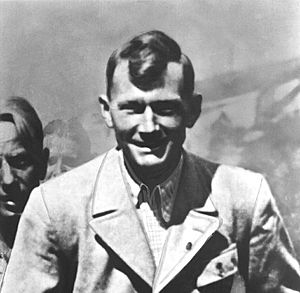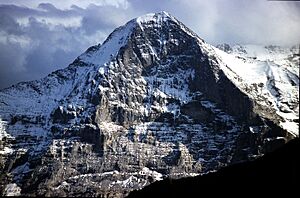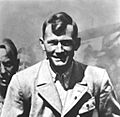Heinrich Harrer facts for kids
Quick facts for kids
Heinrich Harrer
|
|
|---|---|

Harrer in the 1930s
|
|
| Born |
Heinrich Josef Harrer
6 July 1912 Hüttenberg, Austria-Hungary
|
| Died | 7 January 2006 (aged 93) Friesach, Austria
|
| Nationality | Austrian |
| Alma mater | University of Graz |
| Occupation | Mountaineer, Sportsman Geographer, Author |
| Known for | Seven Years in Tibet (1952) The White Spider (1959) |
| Spouse(s) | Charlotte Wegener (1938–1943) Margarethe Truxa (1953–1958) Katharina Haarhaus (1962–2006, his death) |
Heinrich Harrer (6 July 1912 – 7 January 2006) was a famous Austrian mountaineer, sportsman, geographer, and author. He was part of the first team to climb the difficult North Face of the Eiger mountain. During World War II, he was held by British forces in India. He later escaped and traveled to Tibet, where he became a close friend and teacher to the young 14th Dalai Lama. Harrer wrote popular books about his adventures, including Seven Years in Tibet and The White Spider.
Contents
Early life and sports
Heinrich Harrer was born in Hüttenberg, Austria, on July 6, 1912. His father worked for the postal service. From 1933 to 1938, Heinrich studied geography and sports at the University of Graz.
He was a talented skier. In 1935, he was chosen for the Alpine skiing competition at the 1936 Winter Olympics. However, the Austrian team did not participate due to a disagreement. In 1937, Harrer won a downhill skiing event at a world student championship.
Conquering the Eiger North Face
Climbing mountains was Heinrich Harrer's greatest passion. He wanted to achieve something amazing to join an expedition to the Himalayas. So, Harrer and his friend, Fritz Kasparek, decided to be the first to climb the North Face of the Eiger mountain in Switzerland. This part of the mountain is very steep and dangerous. Many climbers had lost their lives trying to conquer it.
In July 1938, Harrer and Kasparek began their climb. Halfway up, they met two German climbers, Ludwig Vörg and Anderl Heckmair. The four decided to climb together as one team. Heckmair, who was very experienced, led the way. They faced many dangers, like snow avalanches and falling rocks. But they were strong and reached the summit on July 24, 1938. This first successful climb of the Eiger North Face was a huge event in mountaineering history. Harrer wrote about it in his book The White Spider.
Harrer's wartime experience
In 1939, Heinrich Harrer joined an expedition to the Nanga Parbat mountain in India. While they were there, World War II began. British soldiers arrested Harrer and his team because they were from Austria, which was then part of Germany, an enemy country. They were held in a detention camp in India.
Harrer and his friend, Peter Aufschnaiter, tried to escape many times. Finally, on April 29, 1944, they succeeded. They and five others walked out of the camp. Harrer and Aufschnaiter decided to head for Tibet, hoping to find safety there.
Journey to Tibet
The journey was very difficult. They walked for months, crossing high mountain passes and facing many challenges. Their goal was to reach Lhasa, the capital city of Tibet. They finally arrived in Lhasa on January 15, 1946.
Seven years in Tibet
In Lhasa, Heinrich Harrer became an important person. In 1948, he started working for the Tibetan government. He translated foreign news and became the official photographer for the court.
Harrer soon met the young 14th Dalai Lama, who was then just a boy. The Dalai Lama asked Harrer to teach him about the outside world. Harrer became his tutor, teaching him English, geography, and science. They became very close friends, sharing a special bond that lasted for the rest of Harrer's life. Harrer was amazed at how quickly the Dalai Lama learned new things.
In 1952, Harrer returned to Austria. He wrote about his amazing experiences in Tibet in his book Seven Years in Tibet. This book became a huge bestseller, translated into 53 languages. It even inspired two movies with the same name, one in 1956 and another in 1997, starring Brad Pitt as Harrer.
Later adventures and books
After returning from Tibet, Harrer continued his life of adventure. He lived in Austria and later in Liechtenstein. He went on many expeditions to places like Alaska, the Andes mountains, and Africa.
- In 1953, he explored the source of the Amazon River.
- In 1954, he made the first climbs of several mountains in Alaska, including Mount Deborah and Mount Hunter.
- In 1962, he led the first team to climb the Carstensz Pyramid in Papua, Indonesia. This is the highest peak in Oceania. He wrote about this adventure in his book I Come from the Stone Age.
- He also visited the Xingu Indians in Brazil and crossed the island of Borneo.
Harrer wrote more than 20 books about his travels. Many of his books include photographs that show the traditional culture of Tibet. Besides climbing and exploring, Harrer was also a very good golfer. He won Austrian national championships in 1958 and 1970.
Private life
In 1938, Heinrich Harrer married Lotte Wegener. Her father was Alfred Wegener, a famous German explorer. Their son, Peter Harrer, was born in 1939. Harrer's marriage ended in 1943 while he was still in India. He later married two more times. His last wife, Katharina Haarhaus, remained with him until his death.
Final years and legacy
In the early 1980s, Harrer visited Tibet again. He wrote another book called Return to Tibet: Tibet After the Chinese Occupation. He also wrote his autobiography, Beyond Seven Years in Tibet.
Harrer made about 40 documentary films. He also founded the Heinrich Harrer Museum in Hüttenberg, Austria. This museum is dedicated to Tibet and his adventures. In 2002, the Dalai Lama gave Harrer the Light of Truth Award. This award recognized Harrer's efforts to share the story of Tibet with the world. Heinrich Harrer passed away on January 7, 2006, at the age of 93.
Honours and awards
- 1978: Honorary Medal in Gold of the city of Vienna
- 1980: Gold Medal of the city of Graz
- 1982: Austrian Cross of Honour for Science and Art, 1st class
- 1982: Grand Merit Cross of the Order of Merit of the Federal Republic of Germany
- 1985: Golden Humboldt Medal (Germany)
- 2002: Light of Truth Award (International Campaign for Tibet)
Images for kids
See also
 In Spanish: Heinrich Harrer para niños
In Spanish: Heinrich Harrer para niños




